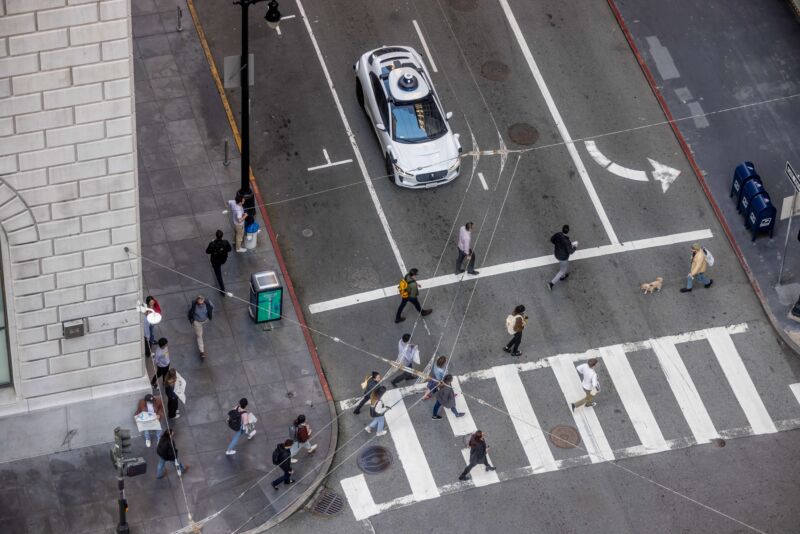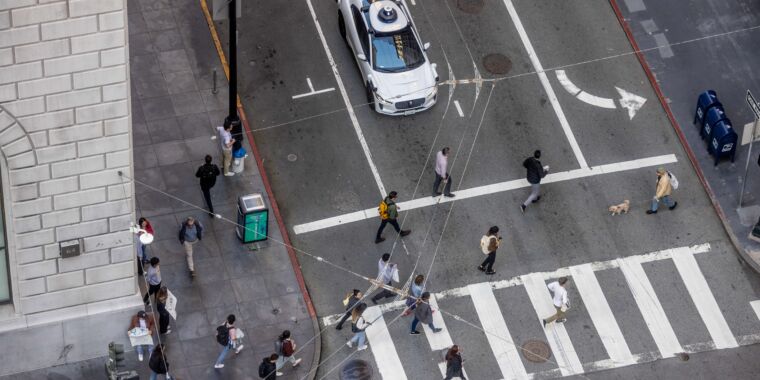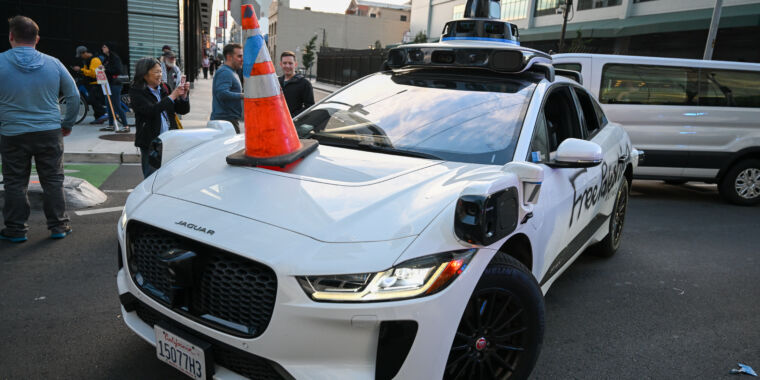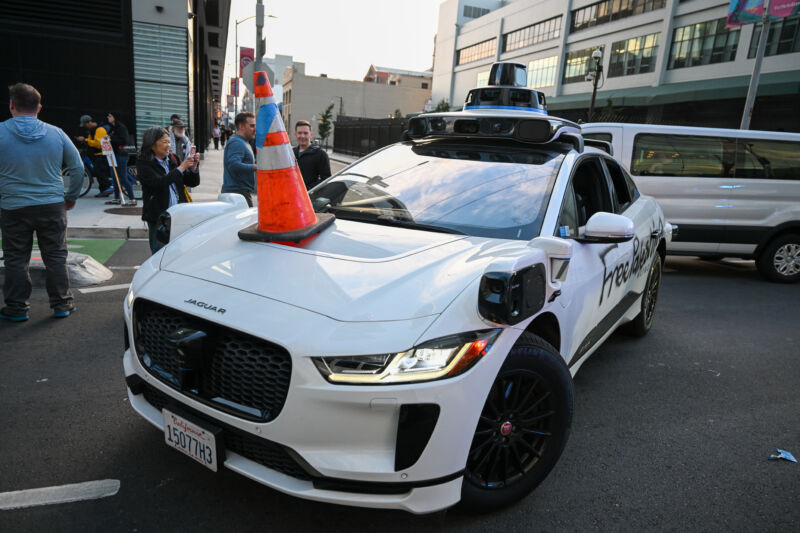Human drivers keep rear-ending Waymos
Traffic safety —
We took a close look at the 23 most serious Waymo crashes.

Enlarge / A Waymo vehicle in San Francisco.
Photo by JasonDoiy via Getty Images
On a Friday evening last November, police chased a silver sedan across the San Francisco Bay Bridge. The fleeing vehicle entered San Francisco and went careening through the city’s crowded streets. At the intersection of 11th and Folsom streets, it sideswiped the fronts of two other vehicles, veered onto a sidewalk, and hit two pedestrians.
According to a local news story, both pedestrians were taken to the hospital with one suffering major injuries. The driver of the silver sedan was injured, as was a passenger in one of the other vehicles.
No one was injured in the third car, a driverless Waymo robotaxi. Still, Waymo was required to report the crash to government agencies. It was one of 20 crashes with injuries that Waymo has reported through June. And it’s the only crash Waymo has classified as causing a serious injury.
Twenty injuries might sound like a lot, but Waymo’s driverless cars have traveled more than 22 million miles. So driverless Waymo taxis have been involved in fewer than one injury-causing crash for every million miles of driving—a much better rate than a typical human driver.
Last week Waymo released a new website to help the public put statistics like this in perspective. Waymo estimates that typical drivers in San Francisco and Phoenix—Waymo’s two biggest markets—would have caused 64 crashes over those 22 million miles. So Waymo vehicles get into injury-causing crashes less than one-third as often, per mile, as human-driven vehicles.
Waymo claims an even more dramatic improvement for crashes serious enough to trigger an airbag. Driverless Waymos have experienced just five crashes like that, and Waymo estimates that typical human drivers in Phoenix and San Francisco would have experienced 31 airbag crashes over 22 million miles. That implies driverless Waymos are one-sixth as likely as human drivers to experience this type of crash.
The new data comes at a critical time for Waymo, which is rapidly scaling up its robotaxi service. A year ago, Waymo was providing 10,000 rides per week. Last month, Waymo announced it was providing 100,000 rides per week. We can expect more growth in the coming months.
So it really matters whether Waymo is making our roads safer or more dangerous. And all the evidence so far suggests that it’s making them safer.
It’s not just the small number of crashes Waymo vehicles experience—it’s also the nature of those crashes. Out of the 23 most serious Waymo crashes, 16 involved a human driver rear-ending a Waymo. Three others involved a human-driven car running a red light before hitting a Waymo. There were no serious crashes where a Waymo ran a red light, rear-ended another car, or engaged in other clear-cut misbehavior.
Digging into Waymo’s crashes
In total, Waymo has reported nearly 200 crashes through June 2024, which works out to about one crash every 100,000 miles. Waymo says 43 percent of crashes across San Francisco and Phoenix had a delta-V of less than 1 mph—in other words, they were very minor fender-benders.
But let’s focus on the 23 most severe crashes: those that either caused an injury, caused an airbag to deploy, or both. These are good crashes to focus on not only because they do the most damage but because human drivers are more likely to report these types of crashes, making it easier to compare Waymo’s software to human drivers.
Most of these—16 crashes in total—involved another car rear-ending a Waymo. Some were quite severe: three triggered airbag deployments, and one caused a “moderate” injury. One vehicle rammed the Waymo a second time as it fled the scene, prompting Waymo to sue the driver.
There were three crashes where a human-driven car ran a red light before crashing into a Waymo:
- One was the crash I mentioned at the top of this article. A car fleeing the police ran a red light and slammed into a Waymo, another car, and two pedestrians, causing several injuries.
- In San Francisco, a pair of robbery suspects fleeing police in a stolen car ran a red light “at a high rate of speed” and slammed into the driver’s side door of a Waymo, triggering an airbag. The suspects were uninjured and fled on foot. The Waymo was thankfully empty.
- In Phoenix, a car ran a red light and then “made contact with the SUV in front of the Waymo AV, and both of the other vehicles spun.” The Waymo vehicle was hit in the process, and someone in one of the other vehicles suffered an injury Waymo described as minor.
There were two crashes where a Waymo got sideswiped by a vehicle in an adjacent lane:
- In San Francisco, Waymo was stopped at a stop sign in the right lane when another car hit the Waymo while passing it on the left.
- In Tempe, Arizona, an SUV “overtook the Waymo AV on the left” and then “initiated a right turn,” cutting the Waymo off and causing a crash. A passenger in the SUV said they suffered moderate injuries.
Finally, there were two crashes where another vehicle turned left across the path of a Waymo vehicle:
- In San Francisco, a Waymo and a large truck were approaching an intersection from opposite directions when a bicycle behind the truck made a sudden left in front of the Waymo. Waymo says the truck blocked Waymo’s vehicle from seeing the bicycle until the last second. The Waymo slammed on its brakes but wasn’t able to stop in time. The San Francisco Fire Department told local media that the bicyclist suffered only minor injuries and was able to leave the scene on their own.
- A Waymo in Phoenix was traveling in the right lane. A row of stopped cars was in the lane to its left. As Waymo approached an intersection, a car coming from the opposite direction made a left turn through a gap in the row of stopped cars. Again, Waymo says the row of stopped cars blocked it from seeing the turning car until it was too late. A passenger in the turning vehicle reported minor injuries.
It’s conceivable that Waymo was at fault in these last two cases—it’s impossible to say without more details. It’s also possible that Waymo’s erratic braking contributed to a few of those rear-end crashes. Still, it seems clear that a non-Waymo vehicle bore primary responsibility for most, and possibly all, of these crashes.
“About as good as you can do”
One should always be skeptical when a company publishes a self-congratulatory report about its own safety record. So I called Noah Goodall, a civil engineer with many years of experience studying roadway safety, to see what he made of Waymo’s analysis.
“They’ve been the best of the companies doing this,” Goodall told me. He noted that Waymo has a team of full-time safety researchers who publish their work in reputable journals.
Waymo knows precisely how often its own vehicles crash because its vehicles are bristling with sensors. The harder problem is calculating an appropriate baseline for human-caused crashes.
That’s partly because human drivers don’t always report their own crashes to the police, insurance companies, or anyone else. But it’s also because crash rates differ from one area to another. For example, there are far more crashes per mile in downtown San Francisco than in the suburbs of Phoenix.
Waymo tried to account for these factors as it calculated crash rates for human drivers in both Phoenix and San Francisco. To ensure an apples-to-apples comparison, Waymo’s analysis excludes freeway crashes from its human-driven benchmark, since Waymo’s commercial fleet doesn’t use freeways yet.
Waymo estimates that human drivers fail to report 32 percent of injury crashes; the company raised its benchmark for human crashes to account for that. But even without this under-reporting adjustment, Waymo’s injury crash rate would still be roughly 60 percent below that of human drivers. The true number is probably somewhere between the adjusted number (70 percent fewer crashes) and the unadjusted one (60 percent fewer crashes). It’s an impressive figure either way.
Waymo says it doesn’t apply an under-reporting adjustment to its human benchmark for airbag crashes, since humans almost always report crashes that are severe enough to trigger an airbag. So it’s easier to take Waymo’s figure here—an 84 percent decline in airbag crashes—at face value.
Waymo’s benchmarks for human drivers are “about as good as you can do,” Goodall told me. “It’s very hard to get this kind of data.”
When I talked to other safety experts, they were equally positive about the quality of Waymo’s analysis. For example, last year, I asked Phil Koopman, a professor of computer engineering at Carnegie Mellon, about a previous Waymo study that used insurance data to show its cars were significantly safer than human drivers. Koopman told me Waymo’s findings were statistically credible, with some minor caveats.
Similarly, David Zuby, the chief research officer at the Insurance Institute for Highway Safety, had mostly positive things to say about a December study analyzing Waymo’s first 7.1 million miles of driverless operations.
I found a few errors in Waymo’s data
If you look closely, you’ll see that one of the numbers in this article differs slightly from Waymo’s safety website. Specifically, Waymo says that its vehicles get into crashes that cause injury 73 percent less often than human drivers, while the figure I use in this article is 70 percent.
This is because I spotted a couple of apparent classification mistakes in the raw data Waymo used to generate its statistics.
Each time Waymo reports a crash to the National Highway Traffic Safety Administration, it records the severity of injuries caused by the crash. This can be fatal, serious, moderate, minor, none, or unknown.
When Waymo shared an embargoed copy of its numbers with me early last week, it said that there had been 16 injury crashes. However, when I looked at the data Waymo had submitted to federal regulators, it showed 15 minor injuries, two moderate injuries, and one serious injury, for a total of 18.
When I asked Waymo about this discrepancy, the company said it found a programming error. Waymo had recently started using a moderate injury category and had not updated the code that generated its crash statistics to count these crashes. Waymo fixed the error quickly enough that the official version Waymo published on Thursday of last week showed 18 injury crashes.
However, as I continued looking at the data, I noticed another apparent mistake: Two crashes had been put in the “unknown” injury category, yet the narrative for each crash indicated an injury had occurred. One report said “the passenger in the Waymo AV reported an unspecified injury.” The other stated that “an individual involved was transported from the scene to a hospital for medical treatment.”
I notified Waymo about this apparent mistake on Friday and they said they are looking into it. As I write this, the website still claims a 73 percent reduction in injury crashes. But I think it’s clear that these two “unknown” crashes were actually injury crashes. So, all of the statistics in this article are based on the full list of 20 injury crashes.
I think this illustrates that I come by my generally positive outlook on Waymo honestly: I probably scrutinize Waymo’s data releases more carefully than any other journalist, and I’m not afraid to point out when the numbers don’t add up.
Based on my conversations with Waymo, I’m convinced these were honest mistakes rather than deliberate efforts to cover up crashes. I could only identify these mistakes because Waymo went out of its way to make its findings reproducible. It would make no sense to do that if the company simultaneously tried to fake its statistics.
Could there be other injury or airbag-triggering crashes that Waymo isn’t counting? It’s certainly possible, but I doubt there have been very many. You might have noticed that I linked to local media reporting for some of Waymo’s most significant crashes. If Waymo deliberately covered up a severe crash, there would be a big risk that a crash would get reported in the media and then Waymo would have to explain to federal regulators why it wasn’t reporting all legally required crashes.
So, despite the screwups, I find Waymo’s data to be fairly credible, and those data show that Waymo’s vehicles crash far less often than human drivers on public roads.
Tim Lee was on staff at Ars from 2017 to 2021. Last year, he launched a newsletter, Understanding AI, that explores how AI works and how it’s changing our world. You can subscribe here.
Human drivers keep rear-ending Waymos Read More »



